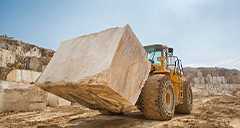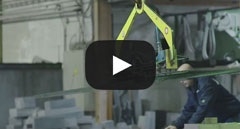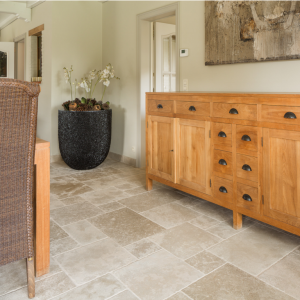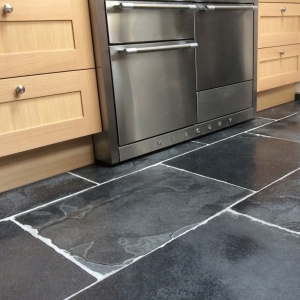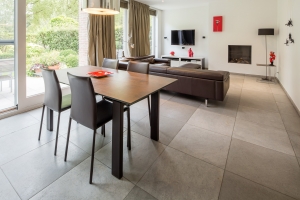




To choose natural stone is to choose a unique product, with elegance and richness that only grows in splendour over the years. The authentic timeless character and durability of a natural stone take every project or home to a higher level.
Not only in facade cladding, the charm of natural stone is an absolute highlight, even floors benefit from the uniqueness of each tile. The fact that this material is ideal to combine with underfloor heating makes natural stone catapult to the top. And that's a good thing too.
A CHOICE FOR LIFE
Nature cannot be imitated
Floors are one of the most intensively used parts in a room and often have to endure a lot of wear and tear in crowded areas. It goes without saying, therefore, that high-quality floor covering is indispensable. And let natural stone now be the perfect material for it.
Many frantic attempts have already succeeded in imitating the beauty of natural stone, but never have they succeeded in uniting the same properties in a material, for the appearance of natural stone remains incomparable; an inexhaustible source of inspiration.
Ecologically advantageous
Natural stone has clear ecological advantages compared to other materials. For example, no energy is needed to develop natural stone because nature does its work. In addition, natural stone can be reused and crushed into granules and aggregates, has an exceptional lifespan, emits no harmful substances and has an exceptional lifespan.
Natural stone has clear ecological advantages compared to other materials.One of the most important findings is in CO2 production: the production and installation of natural stone tiles shows a significantly lower CO2 equivalent than that of other types of floor coverings – for example, natural stone achieves a CO2 equivalent that is 20 times lower than a fitted carpet.
PLAY FOLLOWING RULES OF THIRD ART
Tiling is an art, a motto that is strongly promoted. The lightning-fast evolution of materials and systems gets the technical carousel up and running faster than expected. A floorer must therefore be at home in all markets in order for the installation to proceed according to the rules of the art.
Gluing floor tiles
The bigger the tile, the bigger the teeth of the glue comb should be. First apply the adhesive to the surface with a flat trowel and then form creases with an adhesive comb at an angle of ± 60°. Complete on the underside of the natural stone tile and place the tile on the adhesive bed of the substrate. Position the tile with a horizontal sliding movement in the adhesive bed.
Check regularly whether the back of the tile is in sufficient contact with the adhesive. For interior applications, a minimum adhesive contact surface of 80% applies. This method not only creates an additional bonding bridge between the natural stone tile and the substrate, it also ensures a maximum contact surface.
Floor tiles in the mortar
Floor tiles in mortar have been the traditional placement method for decades, but are now experiencing a decline in popularity. With this method, the tiles are placed full in mortar, on a manually knocked on earth damp stabilised sand bed with a maximum thickness of 5 cm. It is important that no water is used after placing the tiles. Leave the joints exposed for several days so that the moisture can evaporate.
Don't prevent evaporation
During the drying process, evaporation is crucial. Covering the floor with foils or using carpets with low vapour permeability increases the risk of damage. If a covering cannot be avoided, the floor must be exposed every evening, so that the drying process can be continued at night.
HIGH PARTNER WITH FLOOR HEATING
If there is én product is suitable for underfloor heating, then it is natural stone. The accumulating effect of stone provides the storage of heat. A low energy output is responsible for a permanent pleasant warm floor. In the summer, the same phenomenon ensures a comfortable coolness.
The presence of underfloor heating, however, changes the rules of the game for laying floor coverings. To compensate for thicknesses of natural stone tiles or when the floor is uneven, you can lay the tiles with a middle or thick bedflex mortar.
Flat floors, tiles and larger tile surfaces bond better. The adhesive must be suitable for tiling on underfloor heating and must be adapted to the type of tile. A natural stone tile has a certain expansion coefficient, which you can find on the corresponding technical data sheet. The larger the tile, the more flexible the adhesive must be to absorb the expansion or shrinkage.
The most important thing is that 100% filling is achieved. If you apply the adhesive according to the correct adhesive technique, you will obtain a durable, flexible connection between the screed and the tile, and optimum heat transfer from the underlying underfloor heating.
The usefulness of decoupling mats
There is still uncertainty today about the need to decouple tile floors. The prevailing welles-nietes story is hard to deny and the WTCB has not yet taken a position either. Decoupling mats prevent crack formation in the subsurface from extending into the tile surface. Never exclude risk, reduce risk of damage all the more.
It is useful to apply it between the screed and the tiles of working floors and on top of fresh concrete or cement.
Attention with bandages
In the case of underfloor heating, the natural stone tiles should ideally be laid in a pattern so that the joints run in a straight line in both directions &ndash. Semi-squo;n joints or other irregular patterns are possible, provided that decoupling mats and/or highly flexible tile adhesives are used (classification S2). After the installation of the tile floor it is best to wait a while before gradually starting up the underfloor heating (à 5 °C per day). The WTCB prescribes 7 days for thin and medium bed adhesive and 14 days for thick bed mortar.
MAINTENANCE IN MIND
It is sometimes said that natural stone is difficult to maintain; a statement that raises a connoisseur's eyebrow, because maintaining natural stone is actually child's play – provided a number of maintenance tips are kept in mind.
though regular maintenance of floors is the responsibility of the end user, the installer also has a role to play in this context.
First cleaning and maintenance
One week after adding the floor, a one-time cleaning with a suitable cleaning agent is recommended. For acid-resistant natural stone, an appropriate acid can be used to remove the cement screed. Never do this with acid-sensitive natural stone such as marble and lime, as a chemical solution reaction will cause a change in surface condition.
The floor must then dry out sufficiently, i.e. the first three months can be lightly moistened, with the addition of an appropriate care product, without closing off the poriën of the stone. With the glued tile the drying time is one month.
Source: FloorTech

